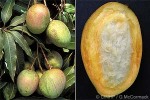Cook Islands Biodiversity Database
Species Page
Mangifera indica
VīMango
Multimedia & Additional Resources
| Type | Description | Download |
| Leaves and fruit (whole and open) | 50KB |
General Information
Cook Islands Distribution
| Southern Group: Present Makatea: Present | ||||||||
RR |
MG |
AT |
MK |
MT |
AK |
PL |
TK |
MN |
++++ |
++++ |
++++ |
++++ |
++++ |
++? |
P |
- |
|
| Northern Group: Present | |||||
TN |
MH |
RK |
PK |
NS |
SW |
+ |
- |
- |
- |
- |
- |
Scientific Taxonomy
Mangifera indica Linnaeus
TAXONOMY: PLANTAE; ANTHOPHYTA (=Angiospermae); MAGNOLIOPSIDA (=Dicotyledones); ROSIDAE; Sapindales; ANACARDIACEAE
More Information
SIGNIFICANCE NOTES -
POSITIVE SIGNIFICANCE: Food (Fruit 4+) Export. Comments: MATERIAL: Timber good for framework and indoor use, soft, whitish yellow, easily worked. Vaka (canoes) on Atiu usually made from trunks.
IDENTIFICATION: Massive evergreen tree to 30m. LEAVES in terminal clusters, alternate, leathery, long-oval to 30x10cm, tip sharp, margin smooth, green, sometimes pink when young. FLOWERS numerous, small, in dense clusters. FRUIT ovoid with a beak, to 12x8cm; ripens with mixture of green, yellow and red; skin thick and tough, flesh orange; stone central, surrounded by fibres.
GENERAL NOTE: Cultivated in India for more than 4000 years, and taken to East Africa by the Persians in the tenth century. Introduced to Hawaii between 1800-1820 from Mexico by Don Francisco de Paul [Wagner et.al.].
Vouchers & References
Vouchers:
None Recorded.
References:
p.196 Wagner et al.- Flowering Plants of Hawaii
p.522 Neal - In Gardens of Hawaii
p.711 Hortus 3rd
p.725 Royal Hort. Soc. Index of Garden Plants
p.454 Tropica
p.3/450 A.C.Smith - Flora Vitiensis Nova
p.276 R* Cheeseman - Flora of Rarotonga
p.69 Wilder - Flora of Rarotonga
p.412h Whistler - Ethnobotany of the Cook Islands
p.23 McCormack/Kunzle - Rarotonga's Mountain Tracks and Plants
Data Update History (information):
zTX, zB02, zM02, zD02
Web Resources
Citation Information
McCormack, Gerald (2007) Cook Islands Biodiversity Database, Version 2007.2. Cook Islands Natural Heritage Trust, Rarotonga. Online at http://cookislands.bishopmuseum.org. ![]()
Please refer to our use policy.

